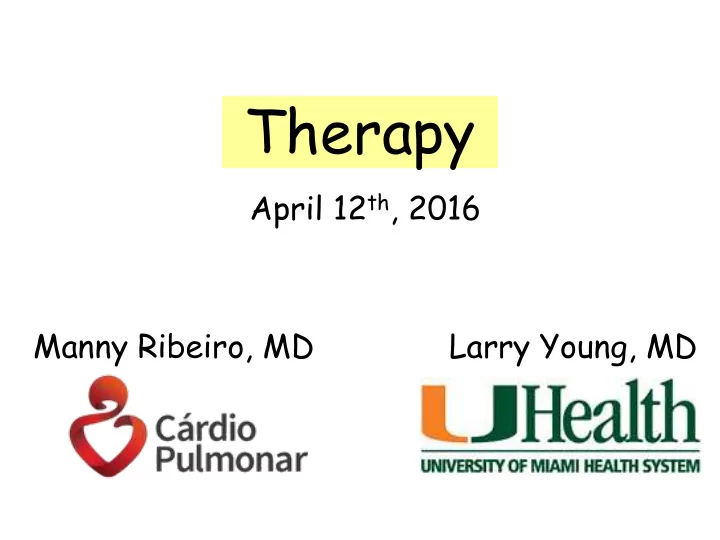

Therapy April 12 th , 2016 Manny Ribeiro, MD Larry Young, MD
Objectives The evidence-based medicine cycle Start with a case scenario Ask the clinical question Critical appraisal • Allocation concealment • Intention-to-treat • Blinding • Follow-up Results: making the math simple!
THE PATIENT The 5 A’s ASSESS APPLY Evidence- based Medicine ASK Cycle APPRAISE ACQUIRE
Case scenario A 67-year-old man presented with productive cough and fever for 3 days Past medical history of coronary artery disease, with a myocardial infarction two years prior Heavy smoker, 2 packs of cigarettes per day for 50 years (100 pack-year)
Bad pneumonia!
Case scenario Also had a new myocardial infarction • Echocardiogram with a drop in ejection fraction to 46% and new segmental wall motion abnormality
His daughter’s request “Please start something for my father to quit smoking before he goes home, otherwise he will just go back to it right after discharge.”
This sounds like PICOTT... Yes, this is “PICOTT”able! Can we PICOTT this?
Clinical question formation P opulation I ntervention C omparison O utcome T ype of Question T ype of (ideal) study design
Clinical question P Smokers admitted to the hospital I Inpatient strategies for smoking cessation C No/other strategies O Quit rate, pneumonia, myocardial infarction T Therapy question T Randomized controlled trial
Search strategy
Critical appraisal = Randomized Controlled Trial
Goals of randomization Treatment Outcome Prognosis X A R P Prognosis X Outcome Control B To keep all known and unknown prognostic variables evenly distributed between the groups
Group A Group B Group C Group D
Allocation concealment
Our population YOU!
List generation Head: Allowed to ask questions ( A ) Tail: NOT Allowed to ask questions ( NA )
Allocation concealment The person who is enrolling participants cannot know, predict, or manipulate the list Trials with inappropriate allocation concealment are associated with larger estimates of treatment effect
Allocation concealment R P O List Allocation generation concealment
Intention-to-treat AKA: Were patients analyzed in the groups to which they were randomized? Teaching method 1
Dead Treatment 1 Alive Dead Alive R Dead Alive Dead Alive Treatment 2
Dead Treatment 1 Alive Dead Alive R Dead Alive Dead Alive Treatment 2
Treatment 1 Dead Dead Alive Alive Dead Dead Alive Alive R Dead Dead Alive Alive Dead Dead Alive Alive Treatment 2
Per ITT Intention-to-treat Protocol Teaching method 2 Stroke Stroke 10 10 10/90 = 20/100 = Surgery 11% 20% + ASA Surgery 100 Cerebro- RD = RD = R vascular 9% 0% disease 100 ASA 20/100 = 20/100 = 200 20% 20% 10 10 Stroke Stroke
Intention-to- treat… Why?? Preserves balance between the groups Reflects real life
Blinding 2 volunteers! Patient Researcher
Shhhhhhh!!
Blinding R P O Blinding List Allocation generation concealment
Blinding Trials with inappropriate blinding are also associated with larger estimates of effect, but not as much as with inappropriate allocation concealment
Allocation Concealment x blinding Allocation Blinding Concealment Patients, caregivers, data Who? Enroller collectors, adjudicators, analysts Group What? The list assignments Part of After When? randomization randomization
Follow-up Patients who are lost often have different prognoses from those who are retained Strategies to deal with lost to follow up: last observation carried forward, worst-case scenario The best solution is to assure a good follow up
Therapy Math
All-cause hospital admissions 41% Step 1: 23% Usual Intensive Risk 41% – 23% = 18% difference Step 2: Subtract: Risk ratio 23% / 41% = 0.56 Step 3: Divide:
Number Needed to Treat What is the risk difference of 18% telling you? In order to save 18, you needed to treat 100 In order to save 1, how many do you need to treat? Formula NNT: 100 / RD
Number Needed to Treat Formula: NNT = 100 / RD NNT = 100 / 18 = 5.5 NNT = 6 You needed to treat 6 patients in order to prevent one extra hospitalization in 2 years
Relative Risk Reduction 20 Teaching method 1 15 By how much (in %) did I reduce? Answer: 25%
All-cause hospital admissions 41% Step 1: 23% Usual Intensive Risk 41% – 23% = 18% difference Step 2: Subtract: Risk ratio 23% / 41% = 0.56 Step 3: Divide:
Relative Risk Reduction Formula: Teaching method 2 RRR = 1 - RR 41% 23% Usual Intensive Risk ratio 23% / 41% = 0.56
Relative Risk Reduction Formula: Teaching method 2 RRR = 1 - RR 41% 41% 23% Usual Intensive 41% / 41% = 1 Risk ratio 23% / 41% = 0.56
Relative Risk Reduction Formula: Teaching method 2 RRR = 1 - RR 41% RRR = 0.44 (44%) 23% Usual Intensive 1 Risk ratio 23% / 41% = 0.56
Math time!
Mortality 12% 2.8% Usual Intensive Risk difference: 9.2% NNT: 11 Risk Ratio: 0.23 RRR: 0.77 (77%)
Take-home points The evidence-based medicine cycle: everything starts and ends with a patient Improper allocation concealment can overestimate the effect size For therapy papers, ITT is preferred to per-protocol analysis Look for who was blinded in the study Make the math simple! Remember to subtract and divide!
Teaching Take-home Points • What strategies did we use to teach these concepts?
Teaching Take-home Points Real clinical case – start with a patient. Clinical question related to different specialties, and even non-medical learners Group activities Pre-mark article – saves time; reduces stress Imperfect articles (you can teach with them) Interactivity Different teaching strategies (visual learners, math lovers) Simplicity: one step at a time, with “no man left behind” Triage: you can’t do it all
Back to our patient… One year after discharge:
Thank you!
Recommend
More recommend